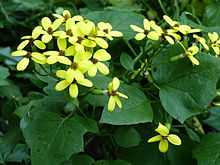Senecio tamoides
| Senecio tamoides | |
|---|---|
 | |
| Scientific classification | |
| Kingdom: | Plantae |
| (unranked): | Angiosperms |
| (unranked): | Eudicots |
| (unranked): | Asterids |
| Order: | Asterales |
| Family: | Asteraceae |
| Tribe: | Senecioneae |
| Genus: | Senecio |
| Species: | S. tamoides |
| Binomial name | |
| Senecio tamoides DC. (1838)[1][2] | |
Senecio tamoides or also known as Canary creeper (a name it shares with Senecio deltoideus Less.[3]) is a climbing member of the genus Senecio of the family Asteraceae.[4]
Description
Scrambling[5] mostly evergreen[6] perennial,[5] creeping along the ground or climbing several meters into the trees.[4]
Stems and leaves: Stems are slender and hairless, up to 2 metres (6.6 ft) tall.[5]
Leaves are bright green, shaped like many ivy[6] with broad, oval and fleshy surfaces, 4 centimetres (1.6 in) long and 7 centimetres (2.8 in) wide, coarsely toothed edges, leaf stalks 2 centimetres (0.79 in) to 5 centimetres (2.0 in) long.[5]
Flowers: Inflorescence is a many-headed,[5] bright yellow,[6] and the flowering spike grows to have a flat top. The flower heads are cylindrical, about 3 millimetres (0.12 in) in diameter; surrounded with a whorl of five to seven bracts, 6 millimetres (0.24 in) to 7 millimetres (0.28 in) long which are surrounded by two to four smaller bracts or bracteoles. Three to six ray florets; each ligule approximately 1 centimetre (0.39 in) long; ten to twelve disc florets, 12 millimetres (0.47 in) to 15 millimetres (0.59 in) long.[5]
When cultivated in the gardens of the National Museums of Kenya, it has orange florets.[7]
Fruits and reproduction: Achenes about 2 millimetres (0.079 in) long, and not hairy; pappus 6 millimetres (0.24 in) to 7 millimetres (0.28 in) long.[5] It grows easily from stem cuttings.[6]
Distribution
It is native to southern Africa where it occurs from the Eastern Cape to eastern Zimbabwe.[8] It grows along evergreen forest margins at altitudes of 300 metres (980 ft) to 1,900 metres (6,200 ft)[4] and in moist gullies.[5]
References
- ↑ Germplasm Resources Information Network (GRIN) (1985-11-07). "Taxon: Senecio tamoides DC." (HTML). Taxonomy for Plants. USDA, ARS, National Genetic Resources Program, National Germplasm Resources Laboratory, Beltsville, Maryland. Retrieved 2008-04-14.
- ↑ Landcare Research. "Senecio angulatus L.f. Suppl. 369 (1781)" (HTML). Flora of New Zealand: Taxa. Landcare Research Allan Herbarium and New Zealand Plant Names Database. Retrieved 2008-04-01.
- ↑ Hyde, Mark; Bart Wursten. "Senecio deltoideus Less." (HTML). Flora of Zimbabwe. Retrieved 2008-04-14.
- ↑ 4.0 4.1 4.2 Hyde, Mark; Bart Wursten. "Senecio tamoides DC." (HTML). Flora of Zimbabwe: Cultivated plants. Retrieved 2008-04-14.
- ↑ 5.0 5.1 5.2 5.3 5.4 5.5 5.6 5.7 National Herbarium of New South Wales. "PlantNET Senecio tamoides DC." (HTML). New South Wales FloraOnline. Royal Botanic Gardens, Sydney. Retrieved 2008-04-14.
- ↑ 6.0 6.1 6.2 6.3 Pienaar, Kristo (2003). "Climbers". Gardening with Indigenous Plants: Easy to Grow Southern African Plants (HTML). Struik. pp. 96 pages. ISBN 1-86872-392-5. Retrieved 2008-04-14.
- ↑ Aluka. "Entry for SENECIO tamoides DC. [family COMPOSITAE]" (HTML). African Plants. Ithaka Harbors, Inc. Retrieved 2008-04-14.
- ↑ Viljoen, Cheris. "Senecio tamoides DC.". plantzafrica.com. Retrieved 11 July 2013.